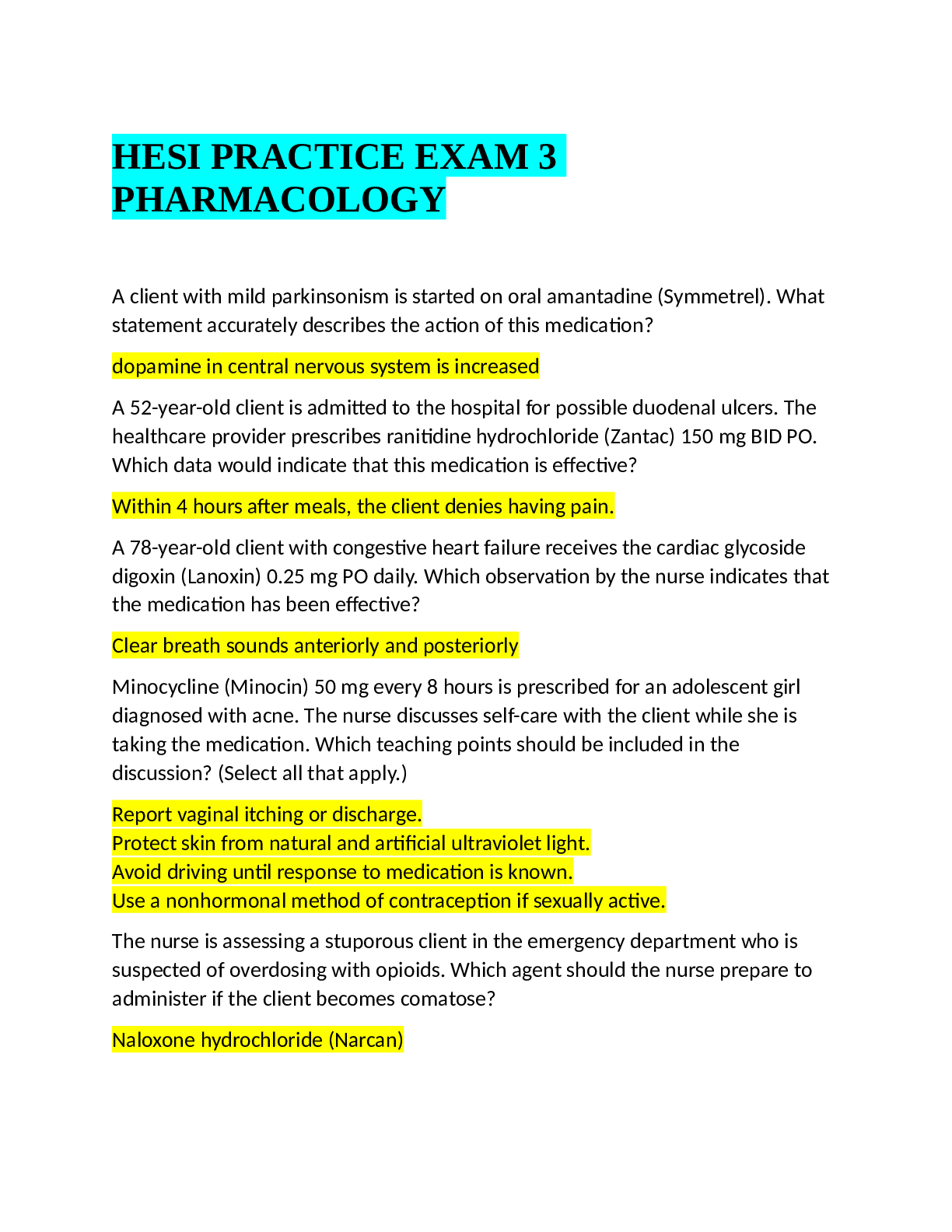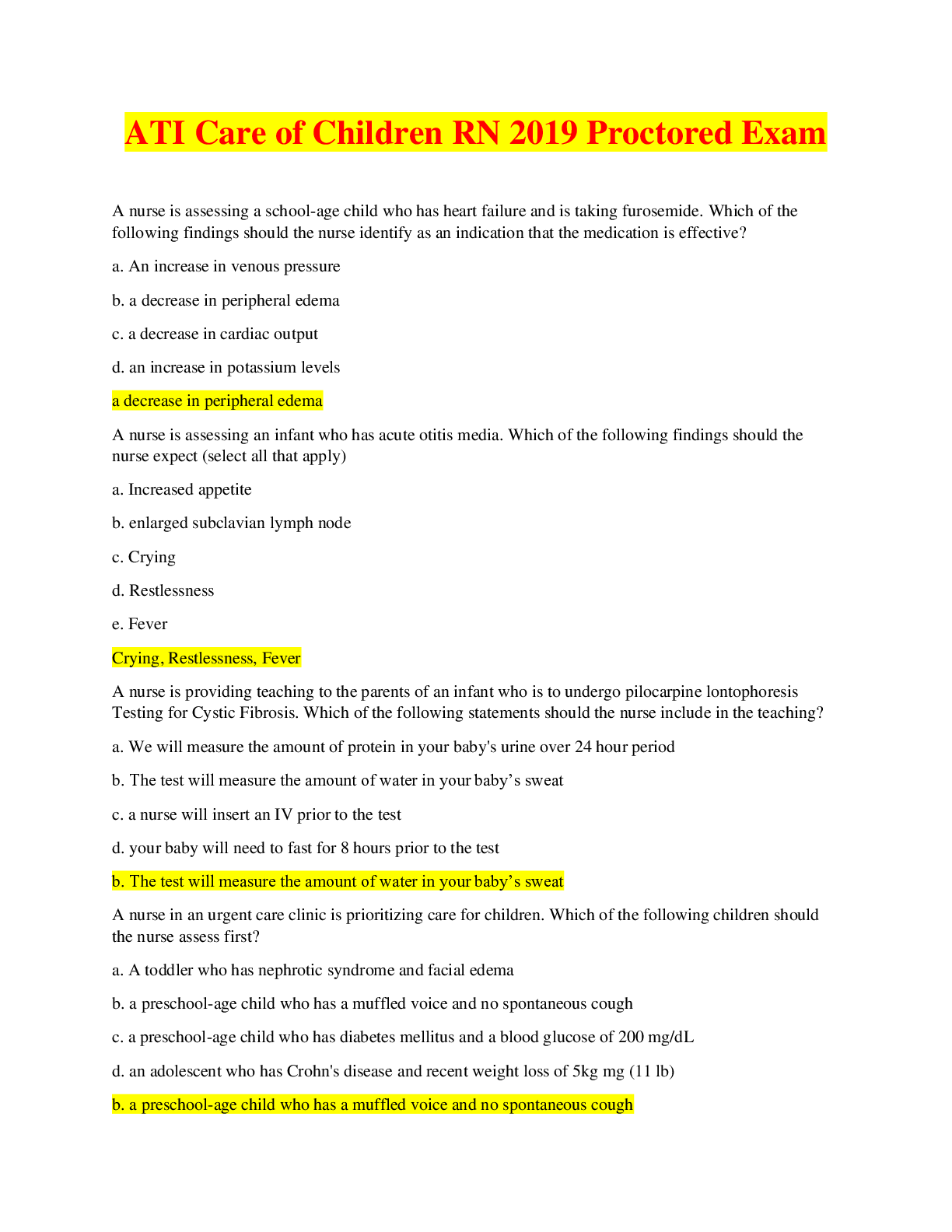*NURSING > EXAM > NURS 6501 Week 4 Scenario_2020 | NURS6501 _ Alterations in the Pulmonary System( Download To Score A (All)
NURS 6501 Week 4 Scenario_2020 | NURS6501 _ Alterations in the Pulmonary System( Download To Score An A)
Document Content and Description Below
NURSING 6501 Week 4 Questions And Answers scenario Alterations in the Pulmonary System An 11-year-old boy is accompanied by his mother to receive medical attention for wheezing and difficulty brea... thing. The patient explains that when he is physically active while playing baseball, the symptoms are worst but improves upon cessation. Furthermore, patient symptoms are becoming worse, while also at rest. The patient lives in an apartment building with an allergy to cat dander. Upon auscultation assessment, wheezing is heard on expiration in all lung fields. The purpose of this paper is to explore how asthma can affect the pulmonary system in pediatrics. Also, the paper will explain the pathophysiology of the patient’s symptoms, the ethnic variables that may impact physiological functioning, and how the process interact to affect the patient. Pathophysiological processes that result in the patient presenting symptoms The 11-year-old boy is complaining of wheezing and difficulty with breathing because his pulmonary system is compromised. Asthma is a chronic inflammatory disorder of the bronchial mucosa that causes bronchial hyperresponsiveness, constriction of the airways, and variable airflow obstruction that is reversible (McCance & Huether, 2019). Airway epithelial exposure to antigen initiates both an innate and adaptive immune response in sensitized patients (McCance & Huether, 2019). The cells that contribute to the persistent inflammation of the bronchial mucosa and hyperresponsiveness of the airways, include the dendritic cells, Th2 lymphocytes, B lymphocytes, mast cells, neutrophils, eosinophils, and basophils (McCance & Huether, 2019). Inflammation, bronchospasm, and mucus production in the airways lead to ventilation-perfusion mismatch (McCance & Huether, 2019). The inflammation and bronchospasms in the airway results in the expiratory wheezes on auscultation. The patient is having difficulty “getting enough air” because of a ventilation-perfusion mismatch that causes hypoxemia and expiratory airway obstruction with air trapping, causing an increased work of breathing. There is both an immediate and delay asthmatic response. Early asthmatic response is a phase of acute bronchoconstriction that reaches a maximum in the first 30 minutes and resolves within 1 to 3 hours (McCance & Huether,2019). On the contrary, late asthmatic response begins 4 to 8 hours after the early response, with an increase in airway hyperresponsiveness (Mccance & Huether, 2019). Because the child is allergic to cat dander, the patient is experiencing an early asthmatic response to the cat dander, which is the trigger for the asthma response. On the other hand, the patient is dealing with shortness of breath while playing baseball because the body requires more oxygen during physical activity. To compensate for the oxygen demand, the heart rate increases to deliver blood supply to the body, and respiration rate increases to give adequate oxygen to the body. In exercise-induced asthma, symptoms usually appear within a few minutes after exercising and worsens 10 to 15 minutes post-workout (Bhatia, Abu-Hasan, & Weinberger, 2019). In some cases, individuals will experience a second episode of symptoms 4 to 12 hours post-workout known as late-phase symptoms (Bhatia, Abu-Hasan, & Weinberger, 2019). Late phase symptoms are less severe but may take up to 24 hours to resolve. Racial/ ethnic variables that may impact physiological functioning Asthma is a familial disorder, and more than 100 genes have been identified to be associated in the susceptibility, pathogenesis, and treatment response of asthma (McCance & Huether, 2019). Asthma is the most prevalent chronic disease in children, affecting about 8.4% of US children between birth and 17 years of age (McCance & Huether, 2019). The prevalence, morbidity, and severity of asthma are higher in children who belong to certain ethnic minorities (African American and Puerto Rican) and whose households report indicators consistent with low socioeconomic status (Forno & Celedon, 2015). Asthma severity in children results from a complex interaction between genetic susceptibility and environmental factors. Compared to rural and suburbs, allergen levels are higher in urban low-income areas and those hosting multiple families (Forno & Celedon, 2015). Urban, low-income children, are disproportionately exposed to multiple indoor allergens and outdoor pollutants, which may influence current asthma symptoms and diagnoses (Carroll, n.d.). How these processes interact to affect the patient In the scenario, the patient asthma flares up are triggered by cat dander and physical activity. A crucial part of asthma management is being mindful of triggers and remaining away from them. It is imperative for a healthcare provider to educate the mother on keeping her son away from cats to avoid asthma attacks. Children with asthma, similar to most children, enjoy being physically active and participating in school activities such as sports. Unfortunately, baseball is provoking respiratory symptoms such as wheezing and shortness of breath. Physical training, exercise, and participation in sports should be encouraged in all children, including those with asthma. Children who have asthma should be educated on how to manage asthma prior to activity to avoid limiting physical movements. Such activities will not improve lung function in the asthmatic but can improve physical fitness, allow participation with peers, and lead to improved quality of life (Hughes, 2014). Summary Asthma is a pulmonary disorder that affects many children. It is important for healthcare providers to understand the pathophysiology of asthma and how it affects the cardiopulmonary system. Proper assessment, diagnosis, and treatment of asthma can improve the overall health of the patient. The asthmatic child and parent(s) will benefit from the advice of a knowledgeable nurse practitioner about asthma, exercise-induced asthma, its presentation, and properly managing it. References Bhatia, R., Abu-Hasan, M., & Weinberger, M. (2019). Exercise-induced dyspnea in children and adolescents: Differential diagnosis. Pediatric Annals, 48(3), 121-127. doi:http://dx.doi.org.ezp.waldenulibrary.org/10.3928/19382359-20190219-02 Carroll, K. (n.d.). Socioeconomic status, race/ethnicity, and asthma in youth. American Journal of Respiratory and Critical Care Medicine, 188(10), 1180-1181. Retrieved from https://www.atsjournals.org/doi/abs/10.1164/rccm.201310-1768ED Forno, E., & Celedon, J. C. (2015). Asthma and ethnic minorities: socioeconomic status and beyond. Current opinion in allergy and clinical immunology, 9(2), 154–160. https://doi.org/10.1097/aci.0b013e3283292207 Hughes D. (2014). Childhood asthma and exercise. Pediatrics & Child Health, 19(9), 467–468. https://doi.org/10.1093/pch/19.9.467 McCance, K. L., & Huether, S. E. (2019). Pathophysiology: the biologic basis for disease in adults and children (8th ed.). St. Louis, MO: Mosby/Elsevier. [Show More]
Last updated: 2 years ago
Preview 1 out of 6 pages

Buy this document to get the full access instantly
Instant Download Access after purchase
Buy NowInstant download
We Accept:

Reviews( 0 )
$16.00
Can't find what you want? Try our AI powered Search
Document information
Connected school, study & course
About the document
Uploaded On
Mar 29, 2021
Number of pages
6
Written in
Additional information
This document has been written for:
Uploaded
Mar 29, 2021
Downloads
0
Views
60




.png)




















